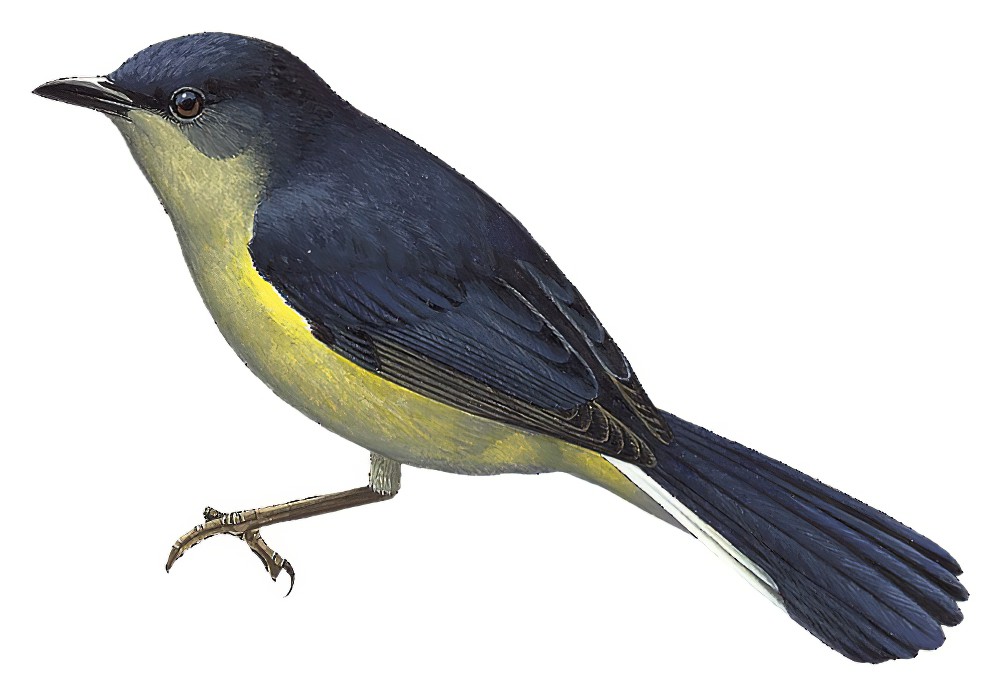Mid-mountain Berrypecker / Melanocharis longicauda

Mid-mountain Berrypecker
SCI Name:
Protonym: Melanocharis longicauda Ann.Mus.Civ.Stor.Nat.Genova 7(1875) p.942 ydP
Taxonomy: Passeriformes / Melanocharitidae / Melanocharis
Taxonomy Code: lebber1
Type Locality: Arfak Mountains.
Author: Salvadori
Publish Year: 1876
IUCN Status: Least Concern
DEFINITIONS
MELANOCHARIS
(Melanocharitidae; Ϯ Black Berrypecker M. nigra) Gr. μελας melas, μελανος melanos black; χαρις kharis, χαριτος kharitos beauty < χαιρω khairō to rejoice; "Melanocharis nigra, Less., sp. Dicæum nigrum, Less. Voy. Coq. i. p. 673; Cent. Zool. pl. 27; Müll. Verh. Ethn. p. 162. Havre Dorey (Less.); Lobo (Müll.) Mus. Lugd. Müller and Schlegel say this bird is not a Dicæum, but a Muscicapine, allied to Boie's genus Hylocharis (since changed to Hyloterpe). It does not seem to me to be referable to either of these genera, but, as far as external appearances go, to be more nearly akin to Dicæum than Hyloterpe. I have therefore used for it the new generic term Melanocharis (μελας, niger, et χαρις, gratia)." (P. Sclater 1858); "Melanocharis Sclater, 1858, Journ. Proc. Linn. Soc. London, Zool., 2, p. 157. Type, by monotypy, Dicaeum niger Lesson." (Salomonsen in Peters 1967, XII, 167).
Var. Merlanocharis.
Synon. Neneba, Pristorhamphus, Sarganura, Urocharis.
longicauda
L. longus long; cauda tail.
● ex “Merle à longue queue du Sénégal” of d’Aubenton 1765-1781, pl. 220, and “Vert-doré” of de Buffon 1770-1785 (syn. Lamprotornis caudatus).
● ex “Petit Figuier à longue queue de la Chine” of Sonnerat 1776, and “Long-tailed Warbler” of Latham 1783 (subsp. Orthotomus sutorius).
● ex “Plumet-blanc” of Brisson 1760 (syn. Pithys albifrons).
● ex “Perruche de Malac” of d’Aubenton 1765-1781, pl. 887, “Grand Perruche à long brins” of de Buffon 1770-1785, and “Malacca Parrakeet” of Latham 1781 (Psittacula).
● ex “Merle Tricolor à Longue Queue” of Levaillant 1801-1804, pl. 114 (unident.).
SUBSPECIES
Mid-mountain Berrypecker (longicauda)
SCI Name: Melanocharis longicauda longicauda
longicauda
L. longus long; cauda tail.
● ex “Merle à longue queue du Sénégal” of d’Aubenton 1765-1781, pl. 220, and “Vert-doré” of de Buffon 1770-1785 (syn. Lamprotornis caudatus).
● ex “Petit Figuier à longue queue de la Chine” of Sonnerat 1776, and “Long-tailed Warbler” of Latham 1783 (subsp. Orthotomus sutorius).
● ex “Plumet-blanc” of Brisson 1760 (syn. Pithys albifrons).
● ex “Perruche de Malac” of d’Aubenton 1765-1781, pl. 887, “Grand Perruche à long brins” of de Buffon 1770-1785, and “Malacca Parrakeet” of Latham 1781 (Psittacula).
● ex “Merle Tricolor à Longue Queue” of Levaillant 1801-1804, pl. 114 (unident.).
Mid-mountain Berrypecker (umbrosa)
SCI Name: Melanocharis longicauda umbrosa
umbrosa / umbrosus
L. umbrosus shady, of shade, of twilight < umbra shade.
Mid-mountain Berrypecker (chloris)
SCI Name: Melanocharis longicauda chloris
CHLORIS
(Fringillidae; Ϯ European Greenfinch C. chloris) Specific name Loxia chloris Linnaeus, 1758; "Verdiers ...... Chloris" (Cuvier 1800); "Chloris Cuvier, 1800, Lecons Anat. Comp., 1, tab. 2. Type, by tautonymy, Loxia chloris Linnaeus." (Paynter in Peters, 1968, XIV, p. 234).
Synon. Chlorospiza, Hypacanthis, Ligurinus.
● (Parulidae; syn. Setophaga Ϯ Northern Parula S. americana) Gr. myth. Chloris the nymph, also known as Flora, wife to Zephyrus and goddess of flowers and springtime (Bob Dowsett in litt.); "Chloris: Sylv. americana Lath. u.s.w." (Boie 1826); "Chloris (not of Cuvier, 1800) Boie, Isis, 1826, p. 972—type, by virtual monotypy, Sylvia americana Latham = Parus americanus Linnaeus." (Hellmayr, 1935, Cat. Birds Americas, Pt. VIII, p. 347).
Mid-mountain Berrypecker (captata)
SCI Name: Melanocharis longicauda captata
captata
L. captatus seized, possessed < capere to seize.
Mid-mountain Berrypecker (orientalis)
SCI Name: Melanocharis longicauda orientalis
orientale / orientalis
L. orientalis eastern, oriental < oriens, orientis east.
● Asia; ex “Anser moschoviticus” of Albin 1731-1738, and “Anser chinensis” of Linnaeus 1747 (syn. Anser cygnoides).
● India; ex Ardea antigone Linnaeus, 1758, “Grus orientalis” of Brisson 1760, and “Indian Crane” of Latham 1785 (syn. Antigone antigone).
● East Indies (= Seram and New Guinea); ex “Casoar des Indes orientales” of d’Aubenton 1765-1781, pl. 313 (syn. Casuarius casuarius).
● India; ex “Eastern Parrot” of Latham 1781 (?syn. Eclectus roratus).
● East Indies (= Amboina); ex “Coucou noir des Indes” (= ♂) and “Coucou tacheté des Indes” (=♀) of Brisson 1760 (subsp. Eudynamys scolopaceus).
● East Indies (=Java); ex “Rollier des Indes” of Brisson 1760 (Eurystomus).
● East Indies; ex “Merula indica” of Brisson 1760, “Merle des Indes Orientales” of d’Aubenton 1765-1781, pl. 273, fig. 2, and “Ash-rumped Thrush” of Latham 1783 (syn. Lalage nigra).
● India; ex “Indian Bee-eater” and “Coromandel Bee-eater” of Latham 1782-1787 (Merops).
● Asia; ex “Onocrotalus” or “Pelecanus” of previous authors (syn. Pelecanus onocrotalus).
● "91. TETRAO. ... orientalis. 12. T. pedibus antice pilosis: abdomine gulaque atra, collari ferrugineo, cauda cuneiformi. Tetrao orientalis. Hasselq. it. 278. n. 43. Perdix damascena. Will. orn. 128. Francolin. Tournef. it. I. p. 158. t. 158. Habitat in Oriente." (Linnaeus 1758) (Pterocles).
● China; ex “Tourterelle brune de la Chine” of Sonnerat 1782, and “Chinese Turtle” of Latham 1783 (Streptopelia).
● China; ex “China Owl” of Latham 1801 (syn. Strix seloputo).
UPPERCASE: current genus
Uppercase first letter: generic synonym
● and ● See: generic homonyms
lowercase: species and subspecies
●: early names, variants, mispellings
‡: extinct
†: type species
Gr.: ancient Greek
L.: Latin
<: derived from
syn: synonym of
/: separates historical and modern geographic names
ex: based on
TL: type locality
OD: original diagnosis (genus) or original description (species)












